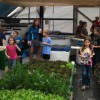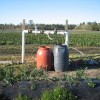 Aquaponics is an intensive sustainable agricultural production system that connects hydroponic and aquaculture systems to produce multiple cash crops with reduced water and fertilizer inputs. It is highly suited for small farm producers targeting local markets and agritourism opportunities. This 10-page fact sheet was written by Richard Tyson and Eric Simonne, and published by the UF Department of Horticultural Sciences, September 2014.
Aquaponics is an intensive sustainable agricultural production system that connects hydroponic and aquaculture systems to produce multiple cash crops with reduced water and fertilizer inputs. It is highly suited for small farm producers targeting local markets and agritourism opportunities. This 10-page fact sheet was written by Richard Tyson and Eric Simonne, and published by the UF Department of Horticultural Sciences, September 2014.
http://edis.ifas.ufl.edu/hs1252
Tag: Eric Simonne
Fertigation for Vegetables: A Practical Guide for Small Fields (HS1206)

More and more farmers are growing small crops of fruits and vegetables for specialty local markets. They commonly grow several crops at different stages of development at the same time so they have a variety of produce to sell to customers. This forces farmers to make several fertilizer calculations because of their diverse crop demands, because water and nutrient requirements vary according to the crop and stage of development. This 7-page fact sheet helps growers correctly interpret fertilizer recommendations and calculate accurate fertilizer amounts to be used based on crop nutrient requirements. Written by Jim DeValerio, David Nistler, Robert Hochmuth, and Eric Simonne, and published by the UF Department of Horticultural Sciences, October 2012.
http://edis.ifas.ufl.edu/hs1206
Are Phosphorous and Phosphoric Acids Equal Phosphorous Sources for Plant Growth? (HS1010/HS254)
 Phosphorus (P) is one of the 17 elements essential for plant growth and development, and is also a key component in some agrochemicals, such as phosphorous acid. Thus, there are two types of P closely associated with crop production. The similarity of terms such as phosphoric acid and phosphorous acid may create some confusion as to the actual content and efficacy of these products. This 7-page fact sheet explains what phosphorous acid is and examines both its fungicidal activity and nutrient value. Written by Asha M. Brunings, Guodong Liu, Eric H. Simonne, Shouan Zhang, Yuncong Li, and Lawrence E. Datnoff, and published by the UF Department of Horticultural Sciences, March 2012.
Phosphorus (P) is one of the 17 elements essential for plant growth and development, and is also a key component in some agrochemicals, such as phosphorous acid. Thus, there are two types of P closely associated with crop production. The similarity of terms such as phosphoric acid and phosphorous acid may create some confusion as to the actual content and efficacy of these products. This 7-page fact sheet explains what phosphorous acid is and examines both its fungicidal activity and nutrient value. Written by Asha M. Brunings, Guodong Liu, Eric H. Simonne, Shouan Zhang, Yuncong Li, and Lawrence E. Datnoff, and published by the UF Department of Horticultural Sciences, March 2012.
http://edis.ifas.ufl.edu/hs254
Controlled-Release Fertilizers for Potato Production in Florida (HS941/HS187)
 The recent emphasis on the development of vegetable production best management practices has prompted a re-examination of fertilization practices in Florida potato production in the St. Johns River watershed. The numbers provided in this 5-page fact sheet serve as a starting point for discussion about the value of using controlled-release fertilizers, which can be a win-win-win opportunity for producers, manufacturers, and regulatory agencies by helping all meet their production, business, and environmental goals. Written by Guodong Liu, Eric H. Simonne, Yuncong Li, Chad M. Hutchinson, Mark Warren, and Steven Lands, and published by the UF Department of Horticultural Sciences, October 2011. (UF/IFAS Photo by Tyler Jones)
The recent emphasis on the development of vegetable production best management practices has prompted a re-examination of fertilization practices in Florida potato production in the St. Johns River watershed. The numbers provided in this 5-page fact sheet serve as a starting point for discussion about the value of using controlled-release fertilizers, which can be a win-win-win opportunity for producers, manufacturers, and regulatory agencies by helping all meet their production, business, and environmental goals. Written by Guodong Liu, Eric H. Simonne, Yuncong Li, Chad M. Hutchinson, Mark Warren, and Steven Lands, and published by the UF Department of Horticultural Sciences, October 2011. (UF/IFAS Photo by Tyler Jones)
http://edis.ifas.ufl.edu/hs187
Glosario de términos usados en riego por goteo y su traducción al inglés (A Glossary of Drip Irrigation Terms and Their Translations in English) (HS1192)

En esta publicación se presenta el léxico técnico de riego por goteo en dos secciones. En la primera sección se describen en orden alfabético los términos y sus definiciones en español. En la segunda sección se enlista de forma alfabética los términos y sus definiciones en inglés.
This publication includes the drip irrigation lexicon in two sections. In the first section, terms and their definitions are alphabetically described in Spanish. The second section lists terms and their definitions in English in alphabetical order. In both sections, each term includes its respective translation into English or Spanish in parenthesis. This 10-page fact sheet was written by Monica Ozores-Hampton, Dagobiet Morales-Garcia, Eric Simonne, and Viviana Medina, and published by the UF Department of Horticultural Sciences, July 2011.
http://edis.ifas.ufl.edu/hs1192
Nickel Nutrition in Plants (HS1191)
This 5-page fact sheet introduces agricultural and horticultural producers to the role and function of the newest identified essential plant nutrient, nickel (Ni). Written by Guodong Liu, E. H. Simonne, and Yuncong Li, and published by the UF Department of Horticultural Sciences, June 2011.
http://edis.ifas.ufl.edu/hs1191
HS1159 Estimating Copper, Manganese and Zinc Micronutrients in Fungicide Applications
HS1159, an 8-page fact sheet by Bee Ling Poh, Amanda Gevens, Eric Simonne, and Crystal Snodgrass, uses tomato as an example to list common sources of micronutrients in common fungicides, estimates micronutrient applications for an entire crop, and discusses the availability of these micronutrients so that the contributions of these sources of micronutrients can be factored in to the fertilizer programs for vegetable crops. Includes references. Published by the UF Department of Horticultural Sciences, August 2009.
http://edis.ifas.ufl.edu/HS1159
HS1156 Review of Nutrient Management Systems for Florida Vegetable Producers
HS1156, a 17-page white paper from the UF/IFAS Vegetable Fertilizer Task Force, identifies differences between actual fertilization practices and UF/IFAS fertilizer recommendations, especially for vegetables grown with subsurface (Central and South Florida) and overhead (Miami-Dade County) irrigation. The recommendations of the VFTF aim at bridging the gaps between science-based results and the diversity in production systems found in the Florida vegetable industry. Includes references. Published by the UF Department of Horticultural Sciences, April 2009.
http://edis.ifas.ufl.edu/HS1156
HS1144/HS388 Drip-irrigation systems for small conventional vegetable farms and organic vegetable farms
HS-1144, a 28-page illustrated fact sheet by Eric Simonne, Robert Hochmuth, Jacque Breman, William Lamont, Danielle Treadwell, and Aparna Gazula, presents the principles behind drip irrigation and some practical guidelines for successful and profitable use of drip irrigation for vegetable production in Florida. Includes references. Published by the UF Department of Horticultural Sciences, June 2008.
http://edis.ifas.ufl.edu/HS388